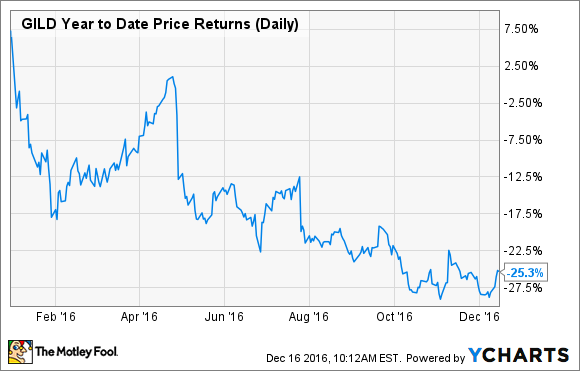Gilead Sciences (GILD +0.38%) hasn't had a good year. Challenges to its dominance in hepatitis C have led to sliding sales, efforts to offset sliding sales via research and development have suffered disappointing blows, and shares have lost 25% of their value. Unfortunately, Gilead Sciences investors got even more bad news yesterday, when a federal jury ruled that the company owes $2.5 billion to Merck & Co. (MRK +1.45%) because of patent infringement.
Is this latest installment of bad news the straw that breaks this camel's back?
IMAGE SOURCE: GETTY IMAGES.
What's at stake
Gilead Sciences' launch of Sovaldi (and later of Harvoni and Eplcusa) has reshaped hepatitis C treatment. In the past, the indication was known for coin-flip cure rates and side-effect-laden 48-week regimens. Today, Gilead Sciences' treatments deliver 90%-plus cure rates, with far fewer side effects, over 12 weeks or less.

DATA SOURCE: GILEAD SCIENCES. AUTHOR'S TABLE.
Revolutionizing hep C treatment with these products has been a boon to Gilead Sciences' balance sheet. Sovaldi-based drugs have racked up roughly $25 billion in sales since their launch, and despite AbbVie Inc. and Merck launching competing hepatitis C drugs, Gilead Sciences' Sovaldi franchise remains the most widely used.
Last quarter alone, Sovaldi-based drugs generated $3.33 billion in sales.
Shrinking sales
While Gilead Sciences' hep C drugs remain market-share leaders, AbbVie and Merck's hep C launches have forced prices on the company's drugs much lower than they've been in the past.
Initially, Sovaldi launched with a retail price of $84,000 for 12 weeks of treatment. However, competition has cut net prices to about $50,000, or less. Gilead Sciences' declining price power has resulted in its hep C sales slowing, despite unit volume remaining strong.
The company's third-quarter hep C sales were 31% lower than in Q3 2015, and hep C sales through the first nine months are down 18.5% from 2015.
Insult to injury
In the face of slowing hep C revenue, management's attempts to kick-start investor enthusiasm have mostly failed this year.
GILD Year to Date Price Returns (Daily) data by YCharts.
In spite of shares trading at a bargain-basement valuation of six times next year's estimated earnings per share, the March shuttering of label-expansion trials for the company's once-promising Zydelig because of safety concerns kicked off a string of disappointing pipeline news in 2016.
For example, in September, the company ended development of its ulcerative colitis drug GS-5745 after determining that the drug's phase 2/3 trial wouldn't pan out.
And in October, Gilead announced it wouldn't conduct late-stage testing of GS-4997, a drug for pulmonary arterial hypertension and diabetic kidney disease, after mid-stage studies fell short.
Pessimism due to those disappointments now increases further following the company's loss in its federal patent case to Merck.
After a short two-hour deliberation, a federal jury found that Gilead Sciences infringed on patents owned by Merck's Idenix, a hep C drug developer acquired by Merck in 2014.
The jury's decision puts Gilead Sciences on the hook to pay Merck a $2.54 billion royalty on past Sovaldi-based drug sales, plus 10% future royalties on Sovaldi-based sales. Also, because it was determined that Gilead Sciences willfully infringed Idenix's patent, Gilead Sciences' $2.5 billion payment could be increased by as much as three times by the judge.
Dark before dawn?
Gilead Sciences will appeal the jury's decision, and if it doesn't win that appeal, then its profit will take a hit because of future royalty payments.
Since it's anyone's guess who will prevail in an appeal, and a decision in an appeal isn't likely for a while, management has some time to take action to restore investor confidence. The company's R&D pipeline still has intriguing candidates, including the autoimmune disease drug filgotinib, which Gilead is co-developing with Galapagos. It also has some intriguing prospects in the works in non-alcoholic steatohepatitis, or NASH, a potential blockbuster indication. Importantly, management is sitting on a massive $31.6 billion cash stockpile that gives it plenty of financial flexibility to ink collaboration deals or buy promising clinical-stage companies lock, stock, and barrel.
So far, Gilead Sciences has been slow to deploy its cash for growth, although that could change in 2017. If that happens, it could propel this company back to growth -- particularly since year-over-year comparisons will be easier in 2017 than they were this year.
Overall, its share price makes Gilead Sciences one of the cheapest big-cap stocks out there, but it needs to start delivering some good news if management hopes to convince long-haul investors to keep sticking around.









